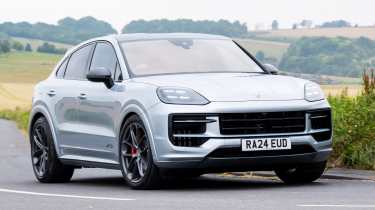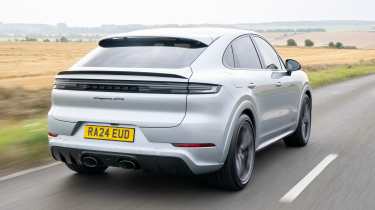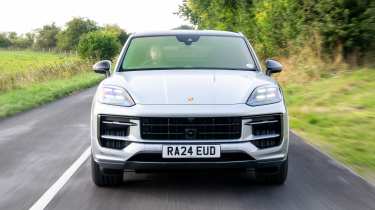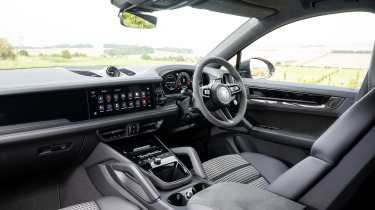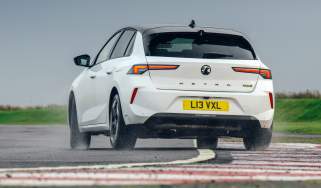Porsche Cayenne GTS Coupe 2024 review – the SUV that might tempt you out of an RS6
The Cayenne GTS is the sweet-spot in the line-up, blending quality and dynamic finesse with just the right amount of power
Porsche’s Cayenne, the SUV that has always been more about the ‘sport’ than the ‘utility’, has never shied away from a fight either from closely-related rivals from Audi, Bentley and Lamborghini or competitors from Mercedes-AMG, BMW and Range Rover. It continues to evolve, roll with the punches and hit back harder than it has before. Even when Aston Martin went for the ultimate sporting SUV crown with the Aston Martin DBX, Porsche rolled up its sleeves and set about creating the Cayenne Turbo GT. It wasn’t exactly a 911 GT3 on stilts, but it did provide an insight into what’s possible when you replace more of the utility aspects with sporting ones.
Today, the ultimate Cayenne is the snappily named Turbo E-Hybrid Coupé with GT Package, but if you can’t spare the £164,800 it costs to own one, Porsche will sell you a GTS for around £60k less. It doesn’t have the headline-grabbing stats of the flagship, but it is designed to be a more driver focused Cayenne with a higher level of dynamic ability – one that might just tempt you out of an RS6.
Every new Cayenne is turbocharged and some also feature hybridisation, but the GTS is battery-free. Its 4-litre twin-turbocharged V8 relies on forced-induction to generate its 493bhp and 487lb ft (39bhp and 29lb ft increases over the previous GTS), which is plenty to be getting on with, even in a machine that crunches the scales at 2190kg.
More reviews
The V8 starts with a flare of revs and settles into a deep, burbling idle once you’ve depressed the start button, which replaces Porsche’s traditional dash-mounted ignition switch. It sounds more authentic than many other modern V8s, but early starts will annoy the neighbours and wake the dog.
Leave the motor in the Normal mode and step-on acceleration isn’t as sharp as it would be if there was an electric motor supporting the engine, the pace building gradually as the revs pick up and torque builds. Reach two-thirds of the way around the tacho and the power takes over, the GTS gaining momentum at a rate that’s somewhere just below peak supersaloon.
Up the ante in Sport or Sport Plus and tenths begin to disappear from the timing sheets, but what you notice more are the quicker reactions to throttle openings. Upshifts from the eight-speed auto speed up too, although downshifts are slower than you expect regardless of the drive mode selected. Its 4.4-second 0-62mph time feels perfectly doable, but the Cayenne doesn't explode forward with the intensity of some modern super-SUVs. It's quick but not startlingly so, yet the level of performance feels appropriate for what is a wide, substantial SUV. Only on well-sighted, flowing A-roads might you want a little more.
Harnessing this performance are a handful of the chassis upgrades derived from the previous-generation Turbo GT. Therefore, front axle pivot bearings have been fitted for improved steering response along with an increase in negative camber at the front by over half a degree. The adaptive air-suspension has been lowered by 10mm, and the PASM damping has been tuned to be sharper, quicker-acting and more controlled. Porsche’s Torque Vectoring Plus is included, and if you’re feeling flush you can also add PDCC active anti roll bars (£2546) and rear-wheel steering (£1325).
The stronger body control is welcome, the dual-valve damper tech managing the weight through direction changes and striking a good balance between pliance and connection to the road surface. It might corner with a flatness that numbs the sense of knowing what’s going on, but there's precision and athleticism to the way the GTS muscles down a road, and you need to be leaning on it very hard to find any cracks.
On tighter, more challenging routes you appreciate the speed and directness of the steering, plus the torque vectoring diff’s ability to overdrive the outside rear to hold a tighter line (or a small slide, if you're committed). And since the V8 doesn’t catapult you between corners at warp speed, you can get into a satisfying rhythm with the GTS without feeling like you’re building unmanageable levels of momentum. Context is important, though, and if you're stepping from an Mercedes-AMG E63, BMW M5 or Audi RS6, the Cayenne will feel less decisive, less agile and a little more cumbersome. But equally, compared to the Cayenne’s SUV rivals you’ll marvel at how it manages to be so car-like, while they feel more like utilitarian vehicles wearing a set of trainers.
Our test car was fitted with the optional carbon-ceramic brakes (yours for a few quid shy of £10,000), and while they offer consistently powerful stopping performance, the pedal is dead on initial travel and can be tricky to modulate when it firms up.
Inside the Cayenne is clean and functional rather than luxurious. New, larger screens are spread across the dash (including a curved digital dial pack and optional passenger infotainment screen), with the climate controls positioned on the centre console with tactile switches for temperature, fan speed and the like. The environment is moody and clinical, and in some respects it doesn’t feel as opulent as a £100k+ SUV should, with little in the way of sumptuous detailing.
As in its sports car cousins, the GTS’s drive mode switch is positioned on the steering wheel, giving access to Off-road, Normal, Sport and Sport Plus settings. Porsche’s PCM remains intuitive to use; the built-in sat-nav is on a par with Google Maps for making the occasional faux-pas but there’s a logic to the layout of the menus, and switching between Apple Carplay doesn’t cause a total infotainment meltdown (as it can in some VW Group products).
Available as a traditional five-door or coupe (priced at £106,100 and £107,700 respectively), the GTS feels like the sweet spot in the Cayenne range, accentuating its dynamic quality while remaining just as usable as other variants. It may not be as thrilling as Aston Martin’s DBX707, nor as plush and cosseting as a Range Rover Sport, but the Cayenne remains the consummate all rounder and shines as brightly as ever in GTS guise.
Price and rivals
Twenty years ago the Cayenne had two core rivals: BMW’s X5 and the Mercedes ML. BMW is still in the game, rivalling the Cayenne with its £128,845 X5 M Competition and £131,545 X6 M Competition (avoid the latter, and consider the former if you really must), while Mercedes’ closest competitor is the £101,360 GLE 53 Hybrid. None of these get close to the Porsche in terms of how they drive, but trump it on tech and wow factor inside.
From within the Volkswagen Group family, there’s Audi’s £116,975 RSQ8 and the Bentley Bentayga S, which is more about bespoke luxury than an engaging drive. Lamborghini’s Urus costs twice as much as the GTS but is nowhere near twice the car.
Aston Martin only offers one flavour of DBX today - the 707 - and while it is one of the few SUVs to out-drive the GTS, it’s more than twice the price. The remaining rival is another Brit (or, rather, a pair): Range Rover’s £114,050 Sport P550e and £171,800 SV. The former has the Porsche trumped for comfort, luxury and effortless ease of driving, with less emphasis on outright performance and more on delivering a seamless journey. Its more brutal SV brother has the ability to match the Porsche when pushed but doesn’t have the ultimate poise of its German rival. Then again, the Cayenne can’t do what either Sport models can achieve off-road.
